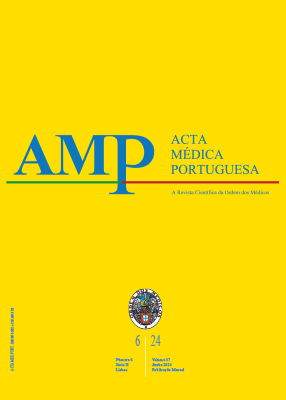Neurological Involvement in a Portuguese Cohort of IgG4-Related Disease
DOI:
https://doi.org/10.20344/amp.20767Keywords:
Immunoglobulin G, Immunoglobulin G4-Related Disease/diagnosis, Nervous System DiseasesAbstract
Introduction: Neurological involvement in immunoglobulin G4-related disease (IgG4-RD) is increasingly recognized. Its diagnosis can be challenging due to clinical mimics and difficulty in obtaining nervous system biopsies. The aim of this study was to describe a cohort of neurological IgG4-RD patients.
Methods: Patients were recruited from a neuroimmunology tertiary center. Clinical, laboratory, neuroimaging and histological data were reviewed.
Results: Fifteen patients (60% women), with a median age of 53 years (48.5 – 65.0) were included: 13 (86.7%) classified as possible IgG4-RD, one (6.7%) as probable and one (6.7%) as definitive. The most common neurological phenotypes were meningoencephalitis (26.7%), orbital pseudotumor (13.3%), cranial neuropathies (13.3%), peripheral neuropathy (13.3%), and longitudinally extensive transverse myelitis (LTEM) (13.3%). Median serum IgG4 concentration was 191.5 (145.0 – 212.0) mg/dL. Seven in 14 patients had CSF pleocytosis (50.0%) and oligoclonal bands restricted to the intrathecal compartment, while most cases presented elevated CSF proteins (64.3%). Magnetic resonance imaging abnormalities included white matter lesions in four (26.7%), hypertrophic pachymeningitis in two (13.3%), and LETM in two (13.3%). Two patients had biopsy-proven IgG4-RD in extra-neurological sites.
Conclusion: This study highlights the phenotypical variability of the neurological IgG4-RD. Biopsy inaccessibility reinforces the importance of new criteria for the diagnosis of this subset of patients.
Downloads
References
AbdelRazek MA, Venna N, Stone JH. IgG4-related disease of the central and peripheral nervous systems. Lancet Neurol. 2018;17:183. DOI: https://doi.org/10.1016/S1474-4422(17)30471-4
Martínez-Valle F, Orozco-Gálvez O, Fernández-Codina A. Update in ethiopathogeny, diagnosis and treatment of the IgG4 related disease. Med Clin. 2018;151:18-25. DOI: https://doi.org/10.1016/j.medcle.2018.05.005
AbdelRazek M, Stone JH. Neurologic features of immunoglobulin G4–related disease. Rheum Dis Clin North Am. 2017;43:621-31. DOI: https://doi.org/10.1016/j.rdc.2017.06.010
Baptista B, Casian A, Gunawardena H, D’Cruz D, Rice CM. Neurological manifestations of IgG4-related disease. Curr Treat Options Neurol. 2017;19:14. DOI: https://doi.org/10.1007/s11940-017-0450-9
Deshpande V, Zen Y, Chan JK, Yi EE, Sato Y, Yoshino T, et al. Consensus statement on the pathology of IgG4-related disease. Mod Pathol. 2012;25:1181-92. DOI: https://doi.org/10.1038/modpathol.2012.72
Umehara H, Okazaki K, Kawa S, Takahashi H, Goto H, Matsui S, et al. The 2020 revised comprehensive diagnostic (RCD) criteria for IgG4-RD. Mod Rheumatol. 2021;31:529-33. DOI: https://doi.org/10.1080/14397595.2020.1859710
Aringer M, Costenbader K, Daikh D, Brinks R, Mosca M, Ramsey-Goldman R, et al. The 2019 american college of rheumatology/european league against rheumatism classification criteria for IgG4-related disease. Arthritis Rheumatol. 2020;72:7-19. DOI: https://doi.org/10.1002/art.41120
Cação G, Calejo M, Alves JE, Medeiros PB, Vila-Cha N, Mendonça T, et al. Clinical features of hypertrophic pachymeningitis in a center survey. Neurol Sci. 2019;40:543-51. DOI: https://doi.org/10.1007/s10072-018-3689-3
Lu LX, Della-Torre E, Stone JH, Clark SW. IgG4-Related hypertrophic pachymeningitis clinical features, diagnostic criteria, and treatment. JAMA Neurol. 2014;71:785-93. DOI: https://doi.org/10.1001/jamaneurol.2014.243
Lindstrom KM, Cousar JB, Lopes MB. IgG4-related meningeal disease: clinico-pathological features and proposal for diagnostic criteria. Acta Neuropathol. 2010;120:765-76. DOI: https://doi.org/10.1007/s00401-010-0746-2
Levraut M, Cohen M, Bresch S, Giordana C, Burel-Vandenbos F, Mondot L, et al. Immunoglobulin G4-related hypertrophic pachymeningitis: a caseoriented review. Neurol Neuroimmunol NeuroInflammation. 2019;6:568. DOI: https://doi.org/10.1212/NXI.0000000000000568
Melenotte C, Seguier J, Ebbo M, Kaphan E, Bernit E, Saillier L, et al. Clinical presentation, treatment and outcome of IgG4-related pachymeningitis: from a national case registry and literature review. Semin Arthritis Rheum. 2019;49:430-7. DOI: https://doi.org/10.1016/j.semarthrit.2019.05.003
De Virgilio A, de Vincentiis M, Inghilleri M, Fabrini G, Conte M, Gallo A, et al. Idiopathic hypertrophic pachymeningitis: an autoimmune IgG4-related disease. Immunol Res. 2017;65:386-94. DOI: https://doi.org/10.1007/s12026-016-8863-1
Mehta SH, Switzer JA, Biddinger P, Rojiani AM. IgG4-related leptomeningitis: a reversible cause of rapidly progressive cognitive decline. Neurology. 2014;82:540-2.
Regev K, Nussbaum T, Cagnano E, Giladi N, Karni A. Central nervous system manifestation of IgG4-related disease. JAMA Neurol. 2014;71:767-70. DOI: https://doi.org/10.1001/jamaneurol.2014.40
Temmoku J, Sato S, Matsumoto H, Fujita Y, Suzuki E, Yashiro-Furuya M, et al. Igg4-related disease complicated by brain parenchymal lesions successfully treated with corticosteroid therapy: a case report. Tohoku J Exp Med. 2020;251:161-8. DOI: https://doi.org/10.1620/tjem.251.161
Vakrakou AG, Evangelopoulos ME, Boutzios G, Tzanetakos D, Tzartos J, Velonakis G, et al. Recurrent myelitis and asymptomatic hypophysitis in IgG4-related disease: case-based review. Rheumatol Int. 2020;40:337-43. DOI: https://doi.org/10.1007/s00296-019-04502-6
Lin J, Zheng L, Zhou D, Hong Z. Immunoglobulin G4–related disease involving both cerebral parenchyma and spinal cord: a case report. J Neuroimmunol. 2019;335:577018. DOI: https://doi.org/10.1016/j.jneuroim.2019.577018
Oliveira V, Moura J, Pinto E, Santos E. Longitudinal extensive transverse myelitis: a presentation of IgG4‐related disease. Neurol Clin Neurosci.2022;10:172-4. DOI: https://doi.org/10.1111/ncn3.12589
Ohyama K, Koike H, Takahashi M, Kawagashira Y, Iijima M, Watanabe H, et al. Immunoglobulin G4-related pathologic features in inflammatory neuropathies. Neurology. 2015;85:1400-7. DOI: https://doi.org/10.1212/WNL.0000000000002039
Mehta SH, Switzer JA, Biddinger P, Rojiani AM. IgG4-related leptomeningitis: a reversible cause of rapidly progressive cognitive decline. Neurology. 2014;82:540-2. DOI: https://doi.org/10.1212/WNL.0000000000000100
Hiraga A, Ozaki D, Tsuneyama A, Ito S, Koide K, Kuwabara S. Corticosteroid-responsive leptomeningitis with IgG4-positive plasma-cell infiltration. J Neurol Sci. 2015;357:338-40. DOI: https://doi.org/10.1016/j.jns.2015.07.048
Boban J, Ardalı S, Thurnher MM. Leptomeningeal form of Immunoglobulin G4-related hypertrophic meningitis with perivascular spread: a case report and review of the literature. Neuroradiology. 2018;60:769-73. DOI: https://doi.org/10.1007/s00234-018-2028-y
Downloads
Published
How to Cite
Issue
Section
License
Copyright (c) 2024 Acta Médica Portuguesa

This work is licensed under a Creative Commons Attribution-NonCommercial 4.0 International License.
All the articles published in the AMP are open access and comply with the requirements of funding agencies or academic institutions. The AMP is governed by the terms of the Creative Commons ‘Attribution – Non-Commercial Use - (CC-BY-NC)’ license, regarding the use by third parties.
It is the author’s responsibility to obtain approval for the reproduction of figures, tables, etc. from other publications.
Upon acceptance of an article for publication, the authors will be asked to complete the ICMJE “Copyright Liability and Copyright Sharing Statement “(http://www.actamedicaportuguesa.com/info/AMP-NormasPublicacao.pdf) and the “Declaration of Potential Conflicts of Interest” (http:// www.icmje.org/conflicts-of-interest). An e-mail will be sent to the corresponding author to acknowledge receipt of the manuscript.
After publication, the authors are authorised to make their articles available in repositories of their institutions of origin, as long as they always mention where they were published and according to the Creative Commons license.









